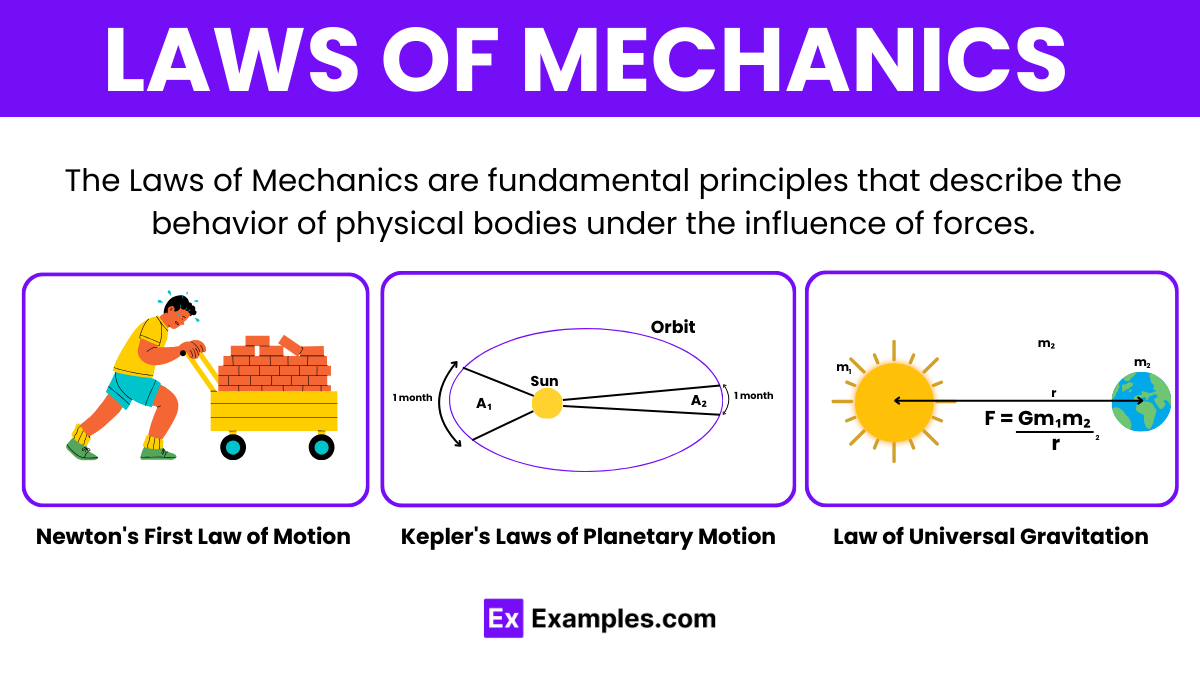Which law states that an object at rest will stay at rest, and an object in motion will stay in motion, unless acted upon by an external force?
Newton\'s First Law
Newton\'s Second Law
Newton\'s Third Law
Law of Universal Gravitation

The laws of mechanics are fundamental principles that describe the behavior of physical systems under the influence of forces. These laws form the foundation of classical mechanics, which is the branch of physics that deals with the motion of objects and the forces that affect them. The core laws of mechanics are encapsulated in Newton’s three laws of motion and the law of universal gravitation.
The foundation of mechanics as a science can be traced back to ancient Greece, where philosophers like Aristotle began to systematically explore physical phenomena. Aristotle’s work laid the groundwork for the study of dynamics, particularly with his concept of natural motion and violent motion, although his approach was more qualitative than quantitative.
The real transformation in mechanics, however, came during the Renaissance with the advent of the Scientific Revolution. A pivotal figure in this period was Galileo Galilei, whose experiments and observations challenged Aristotelian physics and laid the foundation for modern dynamics. Galileo’s studies on the motion of objects, characterized by careful measurement and mathematical description, introduced a new level of precision in understanding how objects move.
Johannes Kepler also contributed significantly with his laws of planetary motion, which described the orbits of planets around the sun. Kepler’s laws were empirical in nature, based on meticulous astronomical observations. These laws not only challenged the geocentric models of the cosmos but also provided crucial data for later theories of motion.
The culmination of these developments came with Sir Isaac Newton in the 17th century, who synthesized the works of his predecessors into a comprehensive theory. Newton formulated the three fundamental laws of motion and the law of universal gravitation, which not only explained earthly motion but also celestial phenomena, establishing the modern science of mechanics. Newton’s work, “Philosophiæ Naturalis Principia Mathematica” (Mathematical Principles of Natural Philosophy), published in 1687, is considered one of the most important works in the history of science.
Newton’s laws of motion and universal gravitation provided a unified description of motion, offering a set of principles that could apply to both terrestrial and celestial bodies. These laws are foundational for classical mechanics, providing the framework that engineers and scientists use to predict the behavior of physical systems under various forces. The principles established in classical mechanics have been expanded upon and refined but remain central to the physical sciences, illustrating the profound impact of these early scientific explorations on our understanding of the natural world.
The fundamental laws of mechanics are Newton’s three laws of motion, which establish the relationships between the forces acting on a body and the motion of that body.
The golden rule of mechanics is often considered to be the principle of conservation of energy, stating that energy cannot be created or destroyed, only transformed from one form to another.
The first rule of mechanics, Newton’s First Law of Motion (Law of Inertia), states that an object at rest stays at rest and an object in motion stays in motion unless acted upon by an external force.
Mechanics is a branch of physics that deals with the motion of bodies under the influence of forces. However, it heavily utilizes mathematics to model and analyze physical systems.
The theory of mechanics refers to the framework and principles that describe the behavior of physical systems under forces and displacements, including statics, dynamics, and fluid mechanics.
Isaac Newton is often regarded as the father of classical mechanics, due to his formulation of the three laws of motion and the law of universal gravitation.
Text prompt
Add Tone
10 Examples of Public speaking
20 Examples of Gas lighting
Which law states that an object at rest will stay at rest, and an object in motion will stay in motion, unless acted upon by an external force?
Newton\'s First Law
Newton\'s Second Law
Newton\'s Third Law
Law of Universal Gravitation
What is the formula for Newton's Second Law of Motion?
F = ma
F = mv
F = mg
F = mv²/r
According to Newton's Third Law of Motion, for every action, there is:
An equal and opposite reaction
A force that cancels it
No reaction
A greater reaction
Which of the following best describes inertia?
The tendency of an object to resist a change in its state of motion
The force applied to an object
The acceleration of an object
The velocity of an object
How does mass affect the inertia of an object?
Greater mass results in less inertia
Greater mass results in more inertia
Mass does not affect inertia
Inertia depends only on velocity
In the context of Newton's Second Law, what does acceleration depend on?
Only the mass of the object
Only the applied force
Both the mass of the object and the applied force
Neither the mass nor the force
Which of the following is an example of Newton's Third Law of Motion?
A book resting on a table
A car accelerating
A rocket launching
A ball rolling down
What is the unit of force in the International System of Units (SI)?
Kilogram
Newton
Joule
Watt
According to Newton's First Law, what happens to an object moving at constant velocity if no external force acts on it?
It speeds up
It slows down
It continues to move at the same veloci
It changes direction
What is the relationship between force and acceleration in Newton's Second Law?
Force is inversely proportional to acceleration
Force is directly proportional to acceleration
Force is unrelated to acceleration
Force is equal to mass divided by acceleration
Before you leave, take our quick quiz to enhance your learning!

